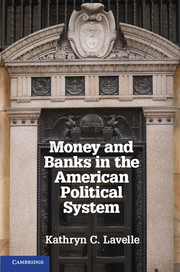Book contents
- Frontmatter
- Contents
- Figures and Tables
- Preface
- Acknowledgments
- Abbreviations
- 1 The Institutional Foundations of Financial Politics in the United States
- Section 1 A Historical Background
- Section 2 Bureaucratic Politics and Finance
- 4 Making Financial Policy in Congress
- 5 Making Financial Policy in the Executive Branch and the Federal Bureaucracy
- 6 Making Financial Policy in the Federal Reserve System
- Section 3 The Operation of the Financial Political Economy
- Section 4 Conclusions
- Glossary
- References
- Index
- References
4 - Making Financial Policy in Congress
Published online by Cambridge University Press: 05 January 2013
- Frontmatter
- Contents
- Figures and Tables
- Preface
- Acknowledgments
- Abbreviations
- 1 The Institutional Foundations of Financial Politics in the United States
- Section 1 A Historical Background
- Section 2 Bureaucratic Politics and Finance
- 4 Making Financial Policy in Congress
- 5 Making Financial Policy in the Executive Branch and the Federal Bureaucracy
- 6 Making Financial Policy in the Federal Reserve System
- Section 3 The Operation of the Financial Political Economy
- Section 4 Conclusions
- Glossary
- References
- Index
- References
Summary
In a statement to the Senate Banking Committee, former Federal Deposit Insurance Corporation (FDIC) Chair William Seidman commented on the problem with banking regulation in the United States: “You have three totally independent agencies in the business. There is no power on earth that can make them agree – not the President, not the Pope, not anybody. The only power that can make them agree is the Congress of the United States by changing the structure so that the present setup does not continue.” Therefore, this chapter begins with Congress. Among the branches of the U.S. government, the legislature sits in the center of the U.S. financial system because Article I of the Constitution gives it the power to tax, borrow money, regulate commerce, and coin money. Moreover, Congress is at the center because it writes the laws. Laws are necessary to grant authority to agencies to regulate the financial services industry and perform other tasks, such as granting bank charters.
Congress plays a central role in all three policy domains associated with financial politics. It actively engages in managing the economy through taxing and spending policy, oversight of monetary policy through the Federal Reserve System, and passing major pieces of regulatory legislation. Moreover, when agencies seek to preserve governing authority, budgets, and personnel, they do so through the legislature. The sheer breadth of these topics demonstrates the great power that Congress has in the financial area. Yet with so many tasks to accomplish, the division of labor within Congress makes it difficult to change the structure of banking regulation as Seidman suggested or to coordinate monetary and fiscal policy in the management of the macroeconomy. Individual members have goals that are more circumscribed. They may want to consolidate their power in a particular policy area or just want to maximize their chance of being reelected. Members do their work in committees that have jurisdiction over different areas. The Chair of each committee in both the House and Senate controls the committee's business. The committees' staff assist members in their work. Leaders of committees tend to be reluctant to see change come about because it could mean a loss of their own authority or ability to shape policy and to control the resources of the federal government.
- Type
- Chapter
- Information
- Money and Banks in the American Political System , pp. 85 - 107Publisher: Cambridge University PressPrint publication year: 2013



